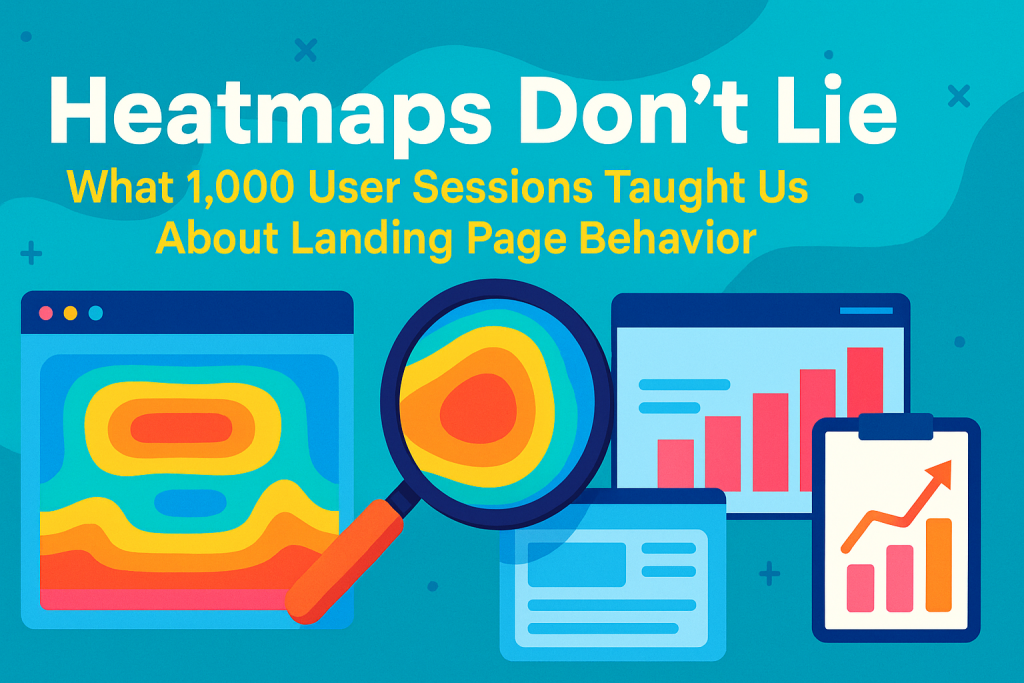
What Heatmaps Reveal About Your Landing Page (And Why You’re Probably Ignoring It)
“Heatmaps don’t lie — but most marketers ignore what they’re screaming.”
— Ad Loft
When it comes to landing page optimization, you don’t need a theory. You need to see what users actually do. That’s where heatmaps come in.
We analyzed over 1,000 user sessions across a range of landing pages. The results? Eye-opening. Whether you’re running Google Ads or organic traffic, heatmaps reveal behavioral insights that no spreadsheet ever could.
Why Heatmaps Matter in CRO
Most marketers obsess over click-through rates, conversion rates, and form submissions. But those metrics only tell you what happened — not why.
Heatmaps show:
- Where users move their mouse
- What they scroll past
- What they click (or don’t)
- Where they stop reading
In other words, heatmaps visually diagnose friction and confusion.
Session Recording Tools We Used
We used a mix of tools to gather data, including:
- Hotjar
- Microsoft Clarity
- Lucky Orange
- Custom-built scroll depth + interaction tracking
Each session was anonymized, and patterns were analyzed across industries, including legal, ecommerce, and home services.
What We Learned from 1,000+ Sessions
📍 Observation #1: Most Users Never See the CTA
Only 54% of users reached the first CTA on mobile.
Solution:
- Move your CTA above the fold or use sticky headers/buttons.
- Break long sections with “micro-CTAs.”
💡 See our full Google Ads landing page optimization guide to fix this immediately.
📍 Observation #2: Walls of Text = Scroll Drop-Off
Pages with large uninterrupted paragraphs caused 30–50% more scroll abandonment.
Solution:
- Use short paragraphs, bold headings, and icon sections.
- Break content into scannable sections with visual hierarchy.
📖 Read: Why Your Landing Page Isn’t Converting (And What to Do About It)
📍 Observation #3: Trust Badges Get Ignored — Unless…
Generic trust badges at the bottom of the page were completely ignored. However, badges near forms or headlines had a measurable impact on engagement and completion.
Solution:
- Place trust signals where action happens (forms, CTAs, etc.)
- Add context: “Used by 4,000+ local customers” > just a badge
📍 Observation #4: Heatmaps Show Friction Before Drop-Off
Hover maps and rage-click tracking revealed pain points in:
- Multi-step forms without guidance
- Poor mobile button spacing
- CTA buttons with vague labels like “Submit”
Solution:
- Simplify forms and add progress bars
- Use actionable button copy: “Get My Free Audit” > “Submit”
- Test layouts using scrollmaps and clickmaps
Real-World Takeaways from Anonymized Sessions
These aren’t theories — they’re session-backed truths.
Case A: Local Cleaning Service
- Before: 5-field form with generic CTA
- After: Condensed form + local trust badge + heatmap-verified CTA placement
🟢 Result: +34% increase in conversions
Case B: eCommerce Landing Page
- Before: Generic product grid with zero hierarchy
- After: Scroll heatmaps used to reorganize content by engagement
🟢 Result: 23% drop in bounce rate, more scroll depth
Case C: Legal PPC Campaign
- Before: CTA buried under text
- After: Heatmap-driven layout + strong header copy
🟢 Result: Improved CTA visibility by 49% on mobile
📊 Want to dive deeper? Try our Landing Page Audit Checklist
Pro Tips for Heatmap-Driven Optimization
“If you don’t track behavior, you’re designing in the dark.” — Ad Loft
✅ Start with mobile
Over 70% of sessions were mobile. Prioritize finger tap zones and fold behavior.
✅ Watch for false bottoms
Users often think the page ends early due to poor spacing. Fix with visual anchors.
✅ Analyze rage clicks
Repeated clicks = frustration. Fix unclear elements or broken buttons.
✅ Combine scroll + click data
Heatmaps are most powerful when layered: scrollmap + clickmap + video.
FAQs About Heatmaps & CRO
What is a heatmap in CRO?
A heatmap shows how users interact with your page — where they click, scroll, and move. It helps you see behavior patterns that affect conversions.
Are heatmaps useful for Google Ads landing pages?
Absolutely. They show whether your offer, trust signals, and CTA are actually being seen and engaged with.
What tools should I use to generate heatmaps?
Popular options include Hotjar, Microsoft Clarity, and Lucky Orange. Most offer free plans to start.
How many sessions do I need to get valid heatmap data?
We recommend at least 200–500 sessions to start seeing consistent behavior trends.
Should I use heatmaps on every page?
Use them on high-traffic, high-intent pages — especially landing pages tied to ads or email campaigns.
Final Thought
Heatmaps don’t guess. They show you exactly where your page is working — and where it’s failing. If your conversion rates are stagnant, don’t redesign blindly. Use behavioral data to guide every update.
“No more guessing. No more theory. Just proof.” — Ad Loft

